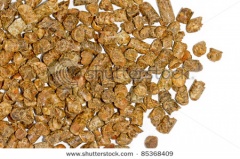Citrus Pellets
| Infobox on Citrus Pellets | |
|---|---|
| Example of Citrus Pellets |  |
| Facts | |
| Origin | This table shows only a selection of the most important countries of origin and should not be thought of as exhaustive.
|
| Stowage factor (in m3/t) | 1.68 m3/t |
| Angle of repose | approx. 40° |
| Humidity / moisture |
|
| Oil content | 0.1 - 1.0% |
| Ventilation | Recommended ventilation conditions: surface ventilation. As with bulk cargoes of expeller, pellets are also often not ventilated. In order to avoid moisture damage on the surface of the cargo, ventilation must not be performed with cold external air. The ventilation system must then be switched to return air. |
| Risk factors | Citrus pellets are liable to the risk of self-heating/spontaneous combustion. |
Citrus Pellets
Contents
Description
Citrus pellets are an animal feed produced from byproducts of citrus processing.
The pellets are composed of peel, pulp and seeds of several species of citrus, dried, to which binders (e.g. molasses, fat or colloidal clays) are added. Hence, the composition is pressed in pelletizing machines or extruders to form cylindrically shaped pellets. Pelletizing reduces the volume, thus enabling better utilization of transport/storage capacity. Another basic material is citrus extraction meal, which is obtained during oil extraction from the seeds and is then pelletized. Pellets generally have the same characteristics (i.e. particularly with regard to oil and water contents) as the original plant residues. However, there is a difference between expeller pellets and extraction meal pellets depending on their origin.
Quality / Duration of storage
Citrus pellets have a brown colour with yellow spots and should be well matured to allow overseas shipment. How long the product should mature is dependent on the oil content.
Shippers should provide certificates in which the moisture, residual oil content and maturing time is mentioned.
<1,5% oil content is extraction meal; >1,5% oil content is expeller.
Applications
Used for feedstuff, especially for dairy cattle, fattened beef cattle and sheep.
Shipment / storage
Citrus pellets are chiefly shipped in bulk and the stowage spaces should allow mechanical ventilation. The product is not to be stowed near/over heat sources (i.e. fuel tanks, hot pipework, engine-room bulkhead etc.)
The travel temperature should preferably be between 5 and 25°C. Temperatures of up to 30°C are admissible for short periods, providing the critical water content of the product is not exceeded - in order to avoid self-heating -.
Product temperatures of 25 - 55°C may occur in tropical ports; if en-route the temperatures are rising >55°C and increasing further, closing of hatch openings and injection of CO2 or inert gas should be considered.
At temperatures of 35 - 40°C within the stow, fat degradation and thus self-heating is activated.
Seawater, rain and condensation water are damaging to the product, since moisture encourages mold, mustiness and self-heating.
Surface ventilation is recommended. However, to avoid moisture damage on the surface of the cargo, ventilation must not be performed with cold external air. The ventilation system must then be switched to return air. As with bulk cargoes of expeller, pellets are also often not ventilated.
An increase in CO2 and CO content in the hold air is indicative of a vigorous heating process resp. fire in the cargo. CO2 has a smothering action on the seat of the fire because it displaces oxygen.
Risk factors
- Self-heating / Spontaneous combustion
- Odor
- Contamination
- Toxicity / Hazards to health
- Shrinkage / Shortage
- Insect infestation / Diseases
Note:(Source including Transport Information Service of the GDV)











